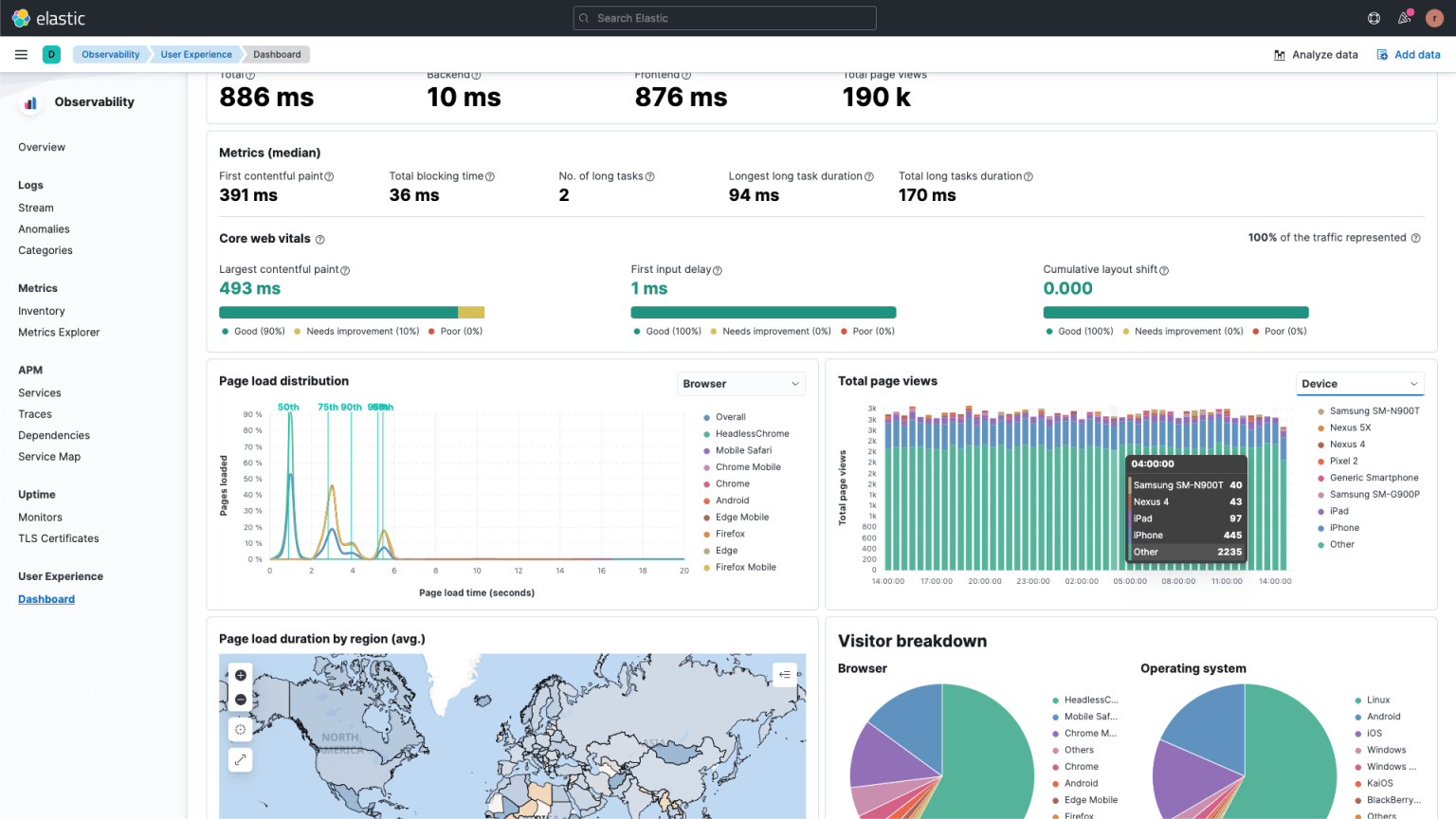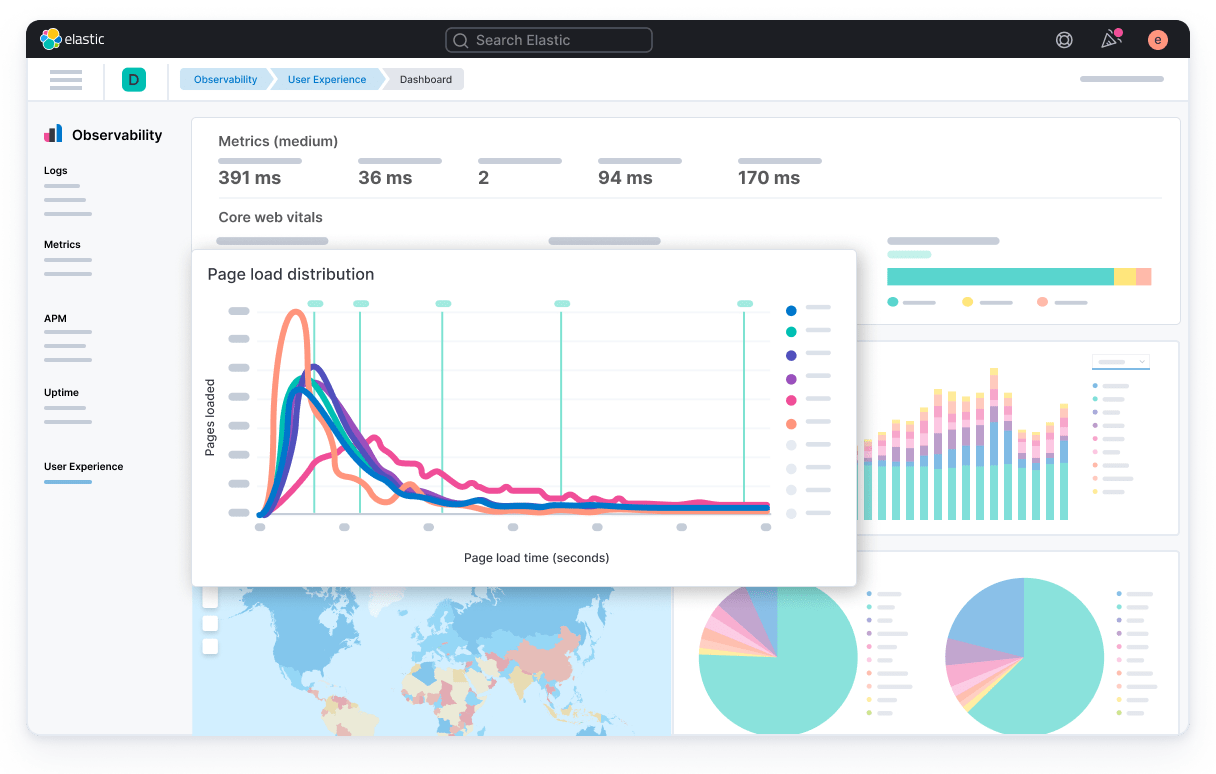
HOW REAL USER MONITORING (RUM) HELPS TO IMPROVE YOUR WEBSITE OR APPLICATION WITH ELASTIC
Real User Monitoring (RUM) is a technique used to collect data on how real users interact with a website or application in real time. It involves tracking user interactions, such as page views, clicks, and load times, directly from the users’ web browsers. This data provides insights into the actual user experience, including performance issues, errors, and user behavior.
BENEFITS OF REAL USER MONITORING (RUM) FOR BUSINESSES
Enhanced User Experience: RUM provides real-time visibility into how users experience your website or application, allowing businesses to identify and address performance issues quickly to ensure a smooth and responsive user experience.
Data-Driven Decision Making: By analyzing RUM data, businesses can make informed decisions about website or application optimizations, prioritize improvements based on actual user behavior, and measure the impact of changes over time.
Improved Customer Satisfaction: Monitoring and optimizing the user experience can lead to increased customer satisfaction, loyalty, and retention, ultimately driving business growth and success.
HOW RUM WORKS IN ELASTIC
Elastic’s Real User Monitoring (RUM) solution allows businesses to collect, analyze, and visualize real-time data on user interactions with their web applications. It involves embedding a lightweight JavaScript agent into web pages or applications to capture performance metrics and user interactions directly from users’ browsers. This data is then sent to Elasticsearch for storage and analysis, where it can be visualized and explored in Kibana dashboards.

REAL USER MONITORING USE CASES
1. Performance Monitoring
Identify Performance Bottlenecks: RUM allows businesses to pinpoint specific areas of their website or application that are experiencing performance issues, such as slow page loads or high server response times. By analyzing performance metrics collected from real user interactions, businesses can diagnose the root causes of these bottlenecks and take proactive measures to address them.
Diagnose Slow Page Loads: With RUM, businesses can track page load times across different devices, browsers, and geographical locations. This granular level of insight enables them to identify pages with the slowest load times and prioritize optimization efforts to improve overall website performance.
Detect Errors Affecting User Experience: RUM provides real-time monitoring of errors occurring within web pages or applications, such as JavaScript errors, HTTP errors, or server-side errors. By promptly detecting and analyzing these errors, businesses can minimize their impact on user experience and prevent potential revenue loss.
2. Feature Adoption
Track User Engagement: RUM allows businesses to track how users interact with specific features or pages within their website or application. By monitoring user interactions, such as clicks, scrolls, or form submissions, businesses can gain insights into feature adoption rates and usage patterns. This data helps businesses identify which features are most popular among users and which may require further optimization or promotion.
Understand Feature Adoption Rates: By analyzing RUM data, businesses can measure the adoption rates of new features or updates rolled out to their website or application. This enables them to gauge the effectiveness of their feature releases and make data-driven decisions about future development efforts.
3. Conversion Optimization
Analyze User Journeys: RUM allows businesses to track user journeys through their website or application, from initial interaction to conversion. By analyzing user behavior, such as page views, clicks, and session duration, businesses can identify friction points in the conversion funnel and optimize the user experience accordingly.
Identify Friction Points: RUM helps businesses identify areas of their website or application where users are dropping off or encountering obstacles in the conversion process. Whether it’s a complex checkout flow, unclear calls-to-action, or technical issues, RUM enables businesses to pinpoint these friction points and implement targeted optimizations to improve conversion rates.
Improve Conversion Rates: By continuously monitoring and analyzing RUM data, businesses can iteratively optimize their conversion funnels to increase conversion rates. Whether through A/B testing, usability improvements, or performance optimizations, RUM provides valuable insights that enable businesses to maximize the effectiveness of their digital experiences and drive revenue growth.

GUIDE THROUGH RUM IN AN EXAMPLE
Let’s say you’re a retail company with an e-commerce website. With Elastic’s RUM solution, you embed the RUM JavaScript agent into your website’s pages. This agent collects data on user interactions, such as page views, clicks, and load times, directly from users’ browsers.
In the Kibana dashboard, you can visualize this data to gain insights into how users are navigating your website, which pages are most popular, and where users are experiencing performance issues. You notice that the checkout process has a high abandonment rate due to slow page load times.
Using this insight, you prioritize optimizing the checkout process to improve performance and reduce friction for users. After implementing optimizations, you monitor the impact on user behavior and conversion rates through RUM data. Over time, you see a significant improvement in checkout completion rates and overall user satisfaction, leading to increased revenue and customer loyalty.
CONCLUSION
In conclusion, Real User Monitoring (RUM) with Elastic offers businesses invaluable insights into user interactions, performance metrics, and conversion rates, enabling them to enhance user experiences and drive business growth. Contact Elk Factory today to implement Elastic’s RUM solution and optimize your digital presence.

